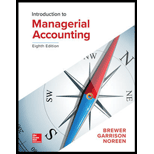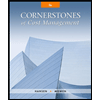
Answer 1:
Variable Costing: In this method, those costs which vary directly with production are considered in unit product cost. Fixed Manufacturing Expenses are treated as period cost and not product cost. Selling Expenses (since they do not vary with production), both variable and fixed, are charged off completely in the period in which the expenses get incurred.
Absorption Costing: In this method, those costs which vary directly with production are considered in unit product cost. Also, fixed Manufacturing Expenses are treated as product cost only. Selling Expenses (since they do not vary with production), both variable and fixed, are charged off completely in the period in which the expenses get incurred.
Unit product Cost under variable costing and absorption costing.
Answer 1:
Answer to Problem 22P
Solution:
| Computation of Unit Product Cost under Variable Costing | ||
| July | August | |
| Direct Material | $ 7 | $ 7 |
| Direct Labour | $ 10 | $ 10 |
| Variable Manufacturing | $ 5 | $ 5 |
| Total Product Cost | $ 22 | $ 22 |
| Computation of Unit Product Cost under Absorption Costing | ||
| July | August | |
| Direct Material | $ 7 | $ 7 |
| Direct Labour | $ 10 | $ 10 |
| Variable Manufacturing Overhead | $ 5 | $ 5 |
| Fixed Manufacturing Overhead | $ 18 | $ 18 |
| Total Product Cost | $ 40 | $ 40 |
Explanation of Solution
- In variable costing, direct material, direct labor and variable manufacturing expenses are considered for unit product cost;
- In absorption costing, direct material, direct labor, variable manufacturing expenses and fixed
manufacturing cost per unit are considered for unit product cost; - Fixed cost per unit is computed as Total manufacturing fixed cost/ Production quantity.
- Given:
Direct Material, Direct Labor and overhead costs are given in the question.
- Formulas:
- Calculation:
Unit Product cost under variable cost for July and August is $ 22 per unit and under absorption costing, it is $ 40 per unit for both July and August.
Answer 2:
Contribution format Income Statement: This is a statement prepared to assess net operating margin of a company.
Income Statements in Variable costing
Answer 2:
Answer to Problem 22P
Solution:
| Denton Company
Income Statement (Contribution Format) |
| July | August | |
| Sales (A) | $ 900,000 | $ 1,200,000 |
| Cost of Goods Sold (B) | $ 330,000 | $ 440,000 |
| Variable selling and administrative expenses (C) | $ 45,000 | $ 60,000 |
| Contribution Margin (D = A − B − C) | $ 525,000 | $ 700,000 |
| Fixed Expenses (Manufacturing + Selling) (E) | $ 560,000 | $ 560,000 |
| Net Operating Income (D − E) | $ (35,000) | $ 140,000 |
Explanation of Solution
- Given:
- Formulas:
- Calculation:
Sales value, Variable selling expenses per unit
Net Operating Income for July is $ (35,000) and for August is $ 140,000 ’
Answer 3
Reconciliation: Reconciliation is done between Net Operating Income as per Variable Costing and that as per Absorption Costing.
The difference between the two net operating income figures would be on account of fixed cost element on inventory.
Under Variable costing, the inventory is valued at Unit product cost as per variable costing method which is direct material plus direct labour plus variable manufacturing expenses whereas under Absorption costing, the inventory is valued at Unit product cost as per absorption costing method which is direct material plus direct labour plus variable manufacturing expenses plus fixed cost per unit.
Due to the inclusion of fixed cost in inventory in absorption costing, following is the impact:
- Opening inventory is higher resulting in decrease in profit
- Closing inventory is higher resulting in increase in profit
Reconciliation of net operating income under variable and absorption costing
Answer 3
Answer to Problem 22P
Solution:
| Reconciliation | |||
| July | August | ||
| Net Operating Income as per Variable Costing | $ (35,000) | $ 140,000 | |
| Closing Stock | 2,500 | - | |
| Opening Stock | - | 2,500 | |
| Difference in Stock (Closing - Opening) | 2,500 | (2,500) | |
| Fixed Overhead per unit | $ 18 | $ 18 | |
| Fixed Overhead on Difference Stock | 45,000 | (45,000) | |
| Profit as per Absorption Costing | $ 10,000 | $ 95,000 | |
Explanation of Solution
- Given:
Net operating income, stock, fixed overhead per unit under variable costing have been taken from computations made above.
- Calculation:
- Net operating income under variable costing is taken as a base;
- Difference of stock quantity is computed as closing stock less opening stock
- This difference in stock is multiplied with fixed overhead per unit (which is considered in unit product cost under absorption costing system). This will the amount of fixed overhead which has been deferred over to the next period;
- In year 1, there is no opening stock but there is closing stock, As such, profit under absorption costing is higher (high closing stock increases profit)
- In year 2, there is opening stock but there is no closing stock, As such, profit under absorption costing is lower (high opening stock decreases profit)
Answer 4
Correctness of break-even point
Answer 4
Answer to Problem 22P
Solution:
Break-even point computed here is 16,000 units. Here, fixed manufacturing expenses have been considered as fixed cost only i.e. period cost. As such, this Break-even point can be used in Variable Costing.
In variable costing, the results are as under:
| July | August | |
| Net Operating Income | $ (35,000) | $ 140,000 |
| Sales Quantity | 15,000 | 20,000 |
| Break-even sales quantity | 16000 | 16000 |
| Difference in quantity (Actual - Breakeven) | (1,000) | 4,000 |
| Contribution per unit | $ 35 | $ 35 |
| Total contribution of difference quantity | $ (35,000) | $ 140,000 |
Total contribution is equal to Net operating Income under variable costing.
Explanation of Solution
Given:
Break-even point is given as 16,000 units
Profit under absorption costing is given as $ 10,000
Net operating income, sales quantity has been taken from computation in previous solutions.
Hence, the break-even point of 16,000 units is correct and is applicable under Variable Costing.
Also, the profit of $ 10,000 is correct under absorption costing.
Want to see more full solutions like this?
Chapter 7 Solutions
Loose Leaf For Introduction To Managerial Accounting
- Solve this question and accountingarrow_forwardCan you help me solve this financial accounting question using valid financial accounting techniques?arrow_forwardMelford Industries sells a product to a wholesaler for $52. The wholesaler applies a 30% markup based on selling price when selling to a retailer. The retailer then applies a 40% markup based on selling price to determine the final price to the consumer. What is the final selling price to the consumer? Answerarrow_forward
- I need help with this general accounting problem using proper accounting guidelines.arrow_forwardIf sales revenue is $220 million and accounts receivable decreased by $30 million, the amount of cash received from customers: a. was $150 million. b. was $125 million. c. depends on the mix of cash sales and credit sales. d. was $250 million.arrow_forwardPlease provide the solution to this financial accounting question with accurate financial calculations.arrow_forward
- Please explain this financial accounting problem by applying valid financial principles.arrow_forwardHenry is an all-equity firm that has 63,500 shares of stock outstanding at a market price of $22.80 per share. The firm is considering a capital structure with 45% debt at a rate of 6% and use the proceeds to repurchase shares. Determine the shares outstanding once the debt is issued.arrow_forwardI want to correct answer general accounting questionarrow_forward
 Managerial Accounting: The Cornerstone of Busines...AccountingISBN:9781337115773Author:Maryanne M. Mowen, Don R. Hansen, Dan L. HeitgerPublisher:Cengage Learning
Managerial Accounting: The Cornerstone of Busines...AccountingISBN:9781337115773Author:Maryanne M. Mowen, Don R. Hansen, Dan L. HeitgerPublisher:Cengage Learning Cornerstones of Cost Management (Cornerstones Ser...AccountingISBN:9781305970663Author:Don R. Hansen, Maryanne M. MowenPublisher:Cengage Learning
Cornerstones of Cost Management (Cornerstones Ser...AccountingISBN:9781305970663Author:Don R. Hansen, Maryanne M. MowenPublisher:Cengage Learning

